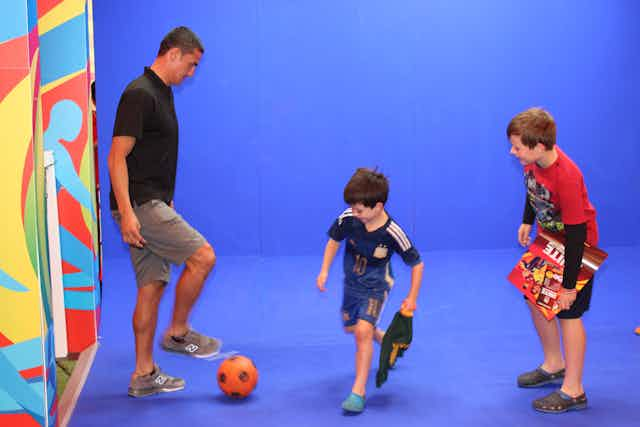Watch out for some clever footwork and ball skills in this weekend’s Asian Cup final when the Socceroos face South Korea at Stadium Australia in Sydney on Saturday.
The championship – played on Australian soil for the first time – has already shown off some amazing skills in a game many regard as the “true” football game.
Tim Cahill’s bicycle kick – in the quater-final of the Socceroos against China – was one of many spectacular goals in the cup, so far.
In displayed a blend of athleticism, timing and power to first position himself in the correct spot, then to elevate himself using drive from the kick leg, then scissoring the legs hard to develop power and to time the kick such that the foot struck the ball at exactly the right moment to propel it towards the goal.
The volley aspect of the skill, where Cahill did not control the ball prior to the strike, shared similarities with his outstanding goal in the World Cup in Brazil against the Netherlands.
The skill of the kick
So what makes a good kick? There have been many kicks employed by players in this tournament using different parts of the foot and foot motion to develop power, impart spin on the ball or to provide deception. Why do these kicks stand out from those we might see in club games or in developing players?
The major factor is technique.
The instep kick, or kicking “off the laces”, is used to develop power as it allows for full extension of the knee and the ball is struck with the hardest part of the foot.
This kick has received substantial research focus in the literature with two key technical features identified as being the most important: greater foot speed; and good contact with the ball.
Foot speed is not only influential in football, where elite players have been found to produce higher foot speeds compared to sub-elite and novice players, but also in Australian rules football.
The principle seems simple enough: striking an object with greater speed will result in more momentum imparted on the ball, although the mechanism is still being debated.
The other key determinant, good contact, has been a focus of research for Hiro Nunome from Fukuoka University, Japan.
Using ultra high speed video analysis, Nunome found that forces during impact are very high, averaging around 1,000 Newtons (N), that’s roughly equivalent to 100kg, across the 1/100th of a second that the ball is on contact with the foot. Further, this could peak as high as 3,000N or 300kg.
Coordination and strength both influence foot speed and the nature of the impact. Elite players exhibit greater strength, better coordination between the thigh and lower leg, tapping in to a biomechanical principle of the summation of segmental interaction.
While novices might try to switch on all the leg muscles at once, the leg of an expert kicker acts more like a whip, enhancing the end point, in this case the foot, speed.
Free Kicks
Watch any free kicks around the box to see if you can see the knuckleball or Butterfly kick being used.
This kick involves striking the ball through its centre of mass on the inside of the foot near the top of the boot so that no spin is imparted on the ball.
The resulting flight is erratic and very deceptive, similar to a floater in Australian football, or the volleyball serve, or a knuckleball in baseball. (See this video tutorial for tips on how to practice yourself.)
Taking a penalty
One of the most important kicks in tournament football is, of course, the penalty goal. With two of this year’s Asian Cup quarter final games (between Iran and Iraq and Japan and UAE) decided by penalties, the ability to convert these kicks is the difference between winning and losing.
The type of kicks employed vary from powerful shots to deceptive chips to well placed strikes into corners.
Research has shown that elite goalkeepers can anticipate which way the penalty shot will be directed between 60% to 70% of the time.
But given the ball takes around half a second to get to the goal, the combination of reaction and movement time required means that they cannot reach the goalpost in that time.
This is why you might see goalkeepers anticipating and beginning to move before the kick is taken. It is also why you might see a stutter run-up with the penalty taker trying to make the goalkeeper move early or why you see many penalty goals directed towards the middle of the goals where the goalkeeper has moved from.
So it would seem that a powerful shot to the corner should be the kick of choice in most cases. The downside for the penalty taker is the speed accuracy trade-off which states that as the kicker attempts to increase the speed of the kick, accuracy will be reduced.
But even with this issue for the goalkeeper, it is of note that that both quarter finals that went to a penalty shootout were won (or perhaps lost depending on whom you supported) without the goalkeepers making a single save –- the striker simply missed the goal.
The reason for these misses are ultimately technical in that the shooter has not oriented the motion of the foot and the foot alignment to direct the ball towards the target.
While the underlying cause of this technical error might be due to pressure or distraction by the goalkeeper, it stands that kickers with better technique, and those that can maintain their technique under pressure, a factor associated with elite performers, will be more successful.
So as we look to the final this weekend, keep an eye out for powerful kicks, knuckleballs and penalty kicking strategies.

